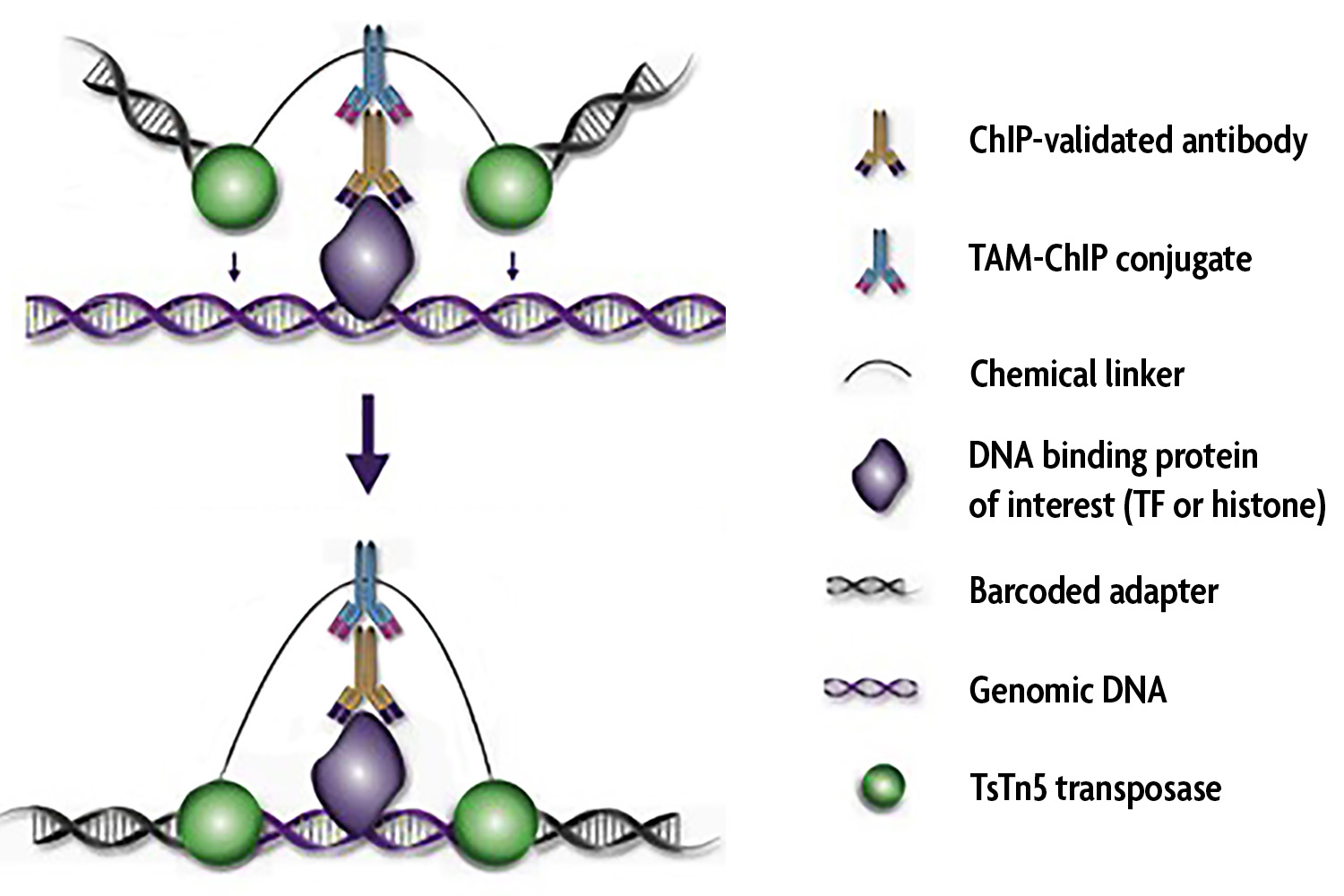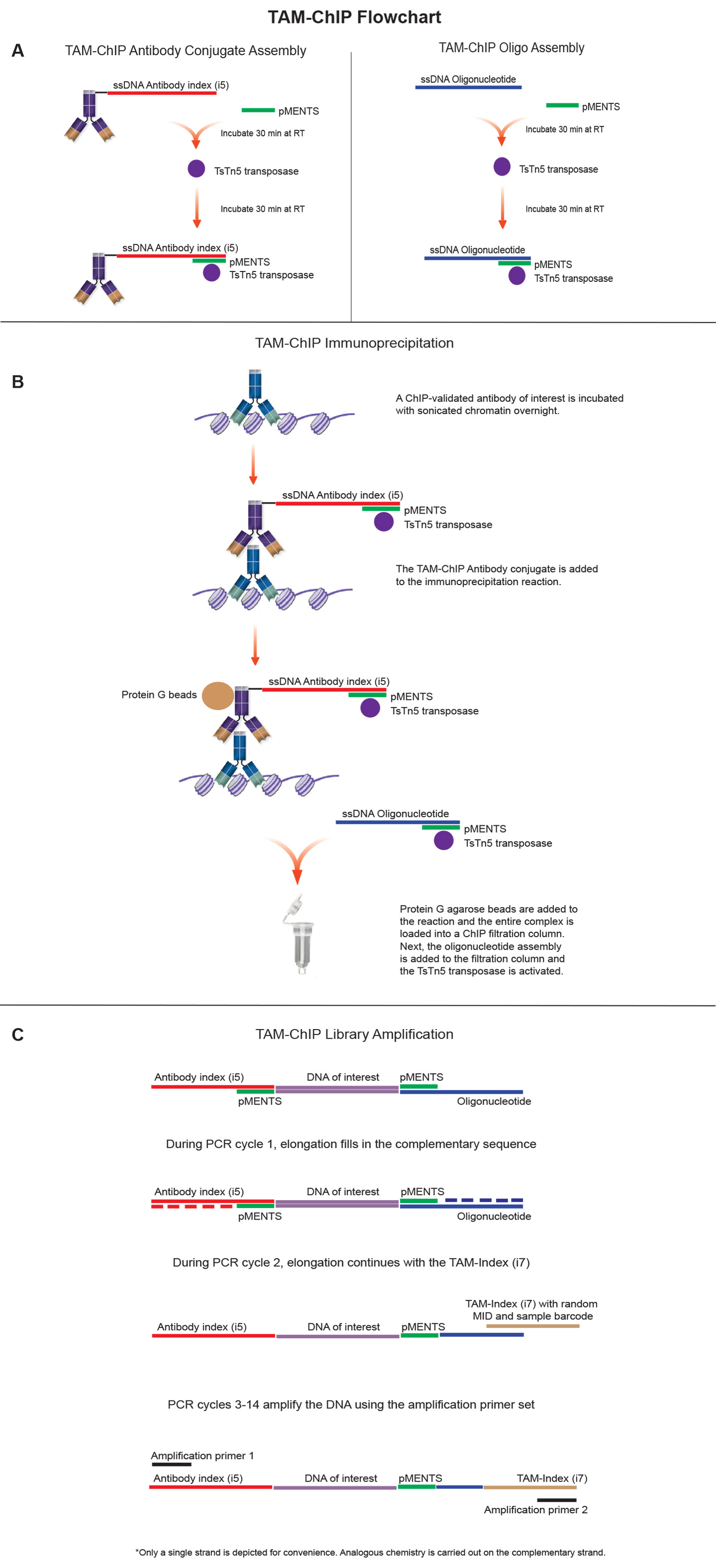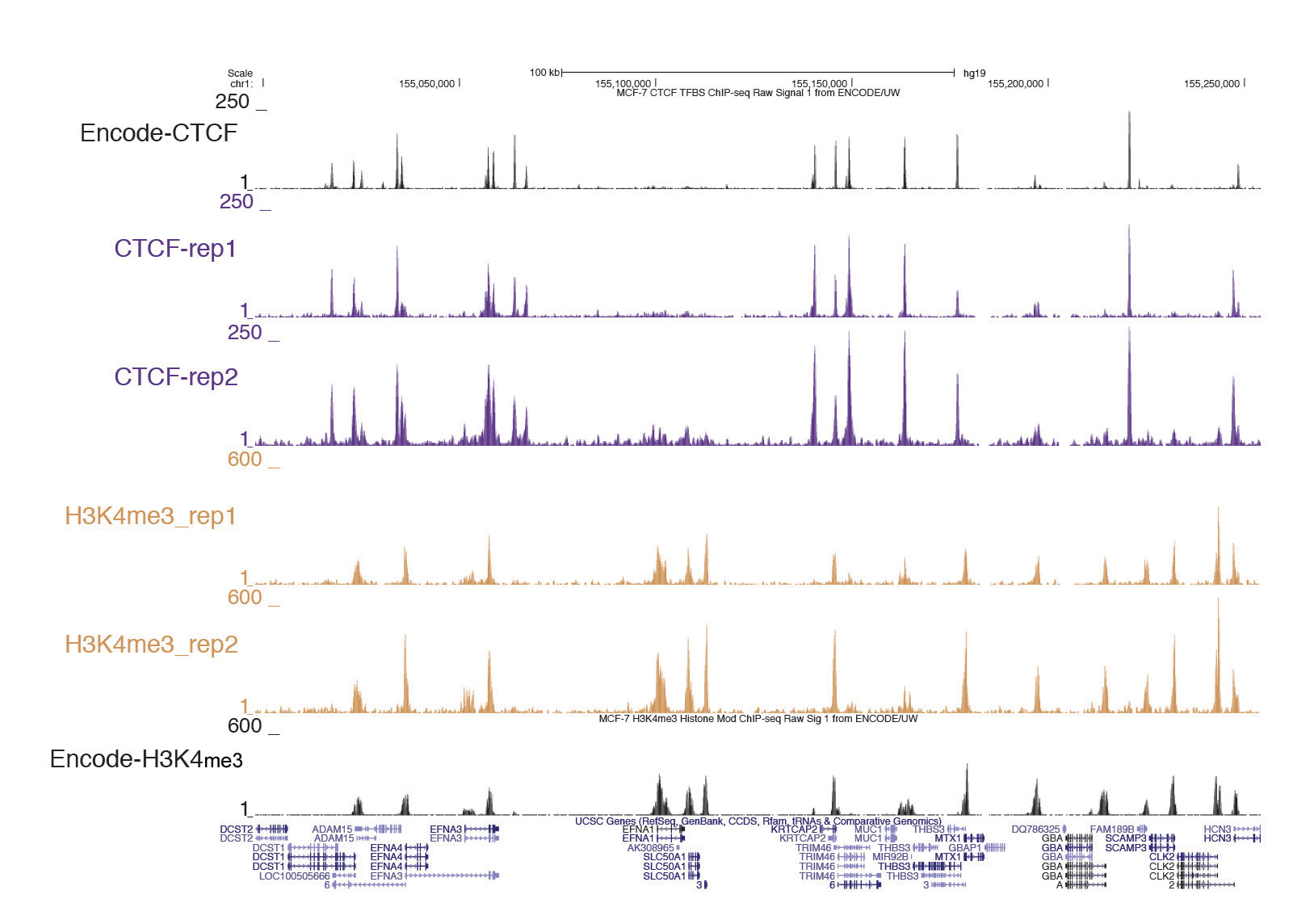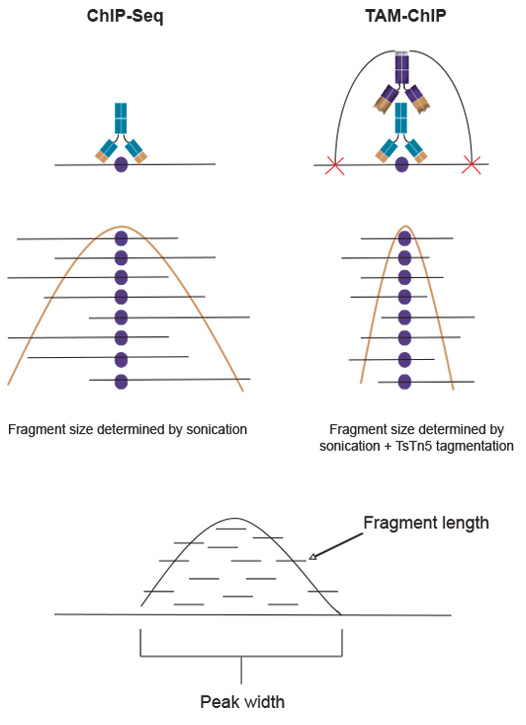Active Motif's TAM-ChIP* technology is a robust chromatin immunoprecipitation (ChIP) method that combines the antibody-directed protein targeting of ChIP and Next-generation sequencing (NGS) library preparation into one step. TAM-ChIP utilizes the specificity of a ChIP-seq validated antibody to target histone or transcription factor binding sites and a TAM-ChIP anti-species antibody conjugate in combination with a unique TsTn5 transposase to deliver barcoded adapter sequences directly into the chromatin surrounding the binding site. These adapter sequences are necessary for library amplification and sequencing using Illumina® platforms. By incorporating the library preparation into the ChIP reaction, you avoid sample loss commonly associated with the multiple end-repair and ligation steps of traditional library preparation methods.
TAM-ChIP products use Directed Transposase Technology and are covered by US Pat. Nos. 9,938,524 & 10,689,643; EP Pat. Nos. 2783001 & 2999784 and related patents and applications
TAM-ChIP™ Highlights
- Tagmentation of the DNA using the TsTn5 transposase aids in chromatin fragmentation and provides higher resolution of protein binding sites
- Avoid sample loss common with traditional library preparation steps
- Highly robust procedure has been validated to profile both histone and transcription factor DNA binding sites
- Unique molecular identifiers (UMIs) enable distinction of PCR duplicates from biological replicates during bioinformatic analysis to increase the number of unique alignments 3-fold
- Multiplex up to 16 samples on the same sequencing flow cell
Video demonstrating the TAM-ChIP technology.
To perform TAM-ChIP you will need a ChIP-validated antibody and the appropriate anti-species TAM-ChIP conjugate. Validated TAM-ChIP Assay Reagents are also available. To learn more about TAM-ChIP, please select the Method or Data tabs below. To download a copy of the manual or the data sheets, please select the Documents tab.
This product is currently not available.
How does TAM-ChIP work?
TAM-ChIP is designed to perform antibody-directed genomic targeting and NGS library preparation at once. First, intact cells are fixed with formaldehyde which cross-links and preserves protein/DNA interactions. DNA is then sheared into small fragments using sonication and incubated with an antibody directed against the DNA-binding protein of interest. Then, a species-specific TAM-ChIP antibody conjugate containing Illumina-compatible sequencing adapters is added to bind the ChIP antibody. Activation of the unique TsTn5 transposase cuts the nearby DNA surrounding the genomic region of interest and pastes the antibody-associated adapters into the DNA sequence. The antibody-bound protein/DNA complexes are immunoprecipitated through the use of Protein G agarose beads and washed to remove non-specific DNA. Following immunoprecipitation, cross-links are reversed, the proteins are removed by Proteinase K, and the DNA is recovered and purified. ChIP enriched DNA is now ready for library amplification and sequencing.

By combining the next-generation library preparation within the ChIP reaction, TAM-ChIP minimizes sample loss. Traditional methods to prepare ChIP-Seq libraries involve a series of processing steps to end repair the DNA and ligate sequencing adapters. This multi-step process can often lead to significant loss of sample material. Another advantage of TAM-ChIP is the inclusion of random barcodes in the adapter sequences. This enables distinction of PCR duplicates from biological replicates during bioinformatic analysis to increase the number of unique alignments.
The TAM-ChIP Flowchart
TAM-ChIP is a multi-step process that involves assembling the unique TsTn5 transposase to the secondary antibody conjugate and an oligonucleotide, prior to immunoprecipitation (A). The TAM-ChIP anti-species antibody conjugate contains a single-stranded oligonucleotide comprised of the i5 antibody index for Next-generation sequencing. Each anti-species antibody has its own i5 index to enable multiplexing of both the anti-rabbit and anti-mouse TAM-ChIP conjugates within the same sequencing reaction. When the antibody conjugate is combined with a single-stranded pMENTS oligonucleotide, the complementary sequences anneal to create a double-stranded recognition sequence for the TsTn5 transposase to assemble. This process loads the inactivated transposase onto the antibody conjugate. At the same time, a single stranded oligonucleotide is also annealed to pMENTS and loaded with inactivated transposase.
During immunoprecipitation (B), the ChIP-validated antibody of interest is combined with sonicated chromatin and incubated overnight. The next day, the assembled TAM-ChIP antibody conjugate is added to the immunoprecipitation reaction. Following a one hour incubation, protein G agarose beads are added to capture the chromatin fragments of interest. Each ChIP reaction is then loaded onto a ChIP filtration column and the oligonucleotide assembled with transposase is added to the column. The TsTn5 transposase is then activated to insert the i5 antibody index and oligonucleotide sequence into the genomic region surrounding the protein of interest. Following washing, elution, Proteinase K treatment, reversal of cross-links and DNA purification, the ChIP library is ready for amplification.
The TAM-ChIP Library is amplified by PCR prior to sequencing (C). During PCR, the second strand of the DNA template is extended. Then, the i7 TAM-ChIP Index which contains the 3 bp sample barcode and 8 bp random molecular identifier (MID) for PCR de-duplication is incorporated into the template. Additional PCR cycles amplify the entire template using the amplification primer mix. Libraries are size-selected and sequenced using Illumina® platforms.

Robust and Reproducible Data
Active Motif's TAM-ChIP Assay Reagents were used to perform TAM-ChIP with 10 µg chromatin from MCF-7 cells. Antibodies to target insulator protein CTCF (4 µg) and Histone H3K4me3 (4 µg) were used in combination with 4 µg TAM-ChIP anti-rabbit conjugate. Libraries were PCR amplified and sequenced using the Illumina NextSeq 500. ChIP-Seq peaks were compared to ENCODE data sets available on the UCSC genome browser. Results show reproducibility between replicates and peaks that are consistent with published data sets.

Figure 1: TAM-ChIP sequencing peaks for CTCF and histone H3K4me3 compared to ENCODE data sets.
TAM-ChIP validated antibodies
Other factors that will influence the success of TAM-ChIP include the abundance of target protein and the quality of the ChIP-Seq antibody. Below are some validated antibodies from Active Motif for use with TAM-ChIP.
| Protein Target | Active Motif Catalog Number | Cell Type Tested |
|---|---|---|
| H3K4me3 | 39915 | MCF-7 |
| H3K9ac | 39917 | MCF-7 |
| H3K27ac | 39685 | MCF-7 |
| CTCF | 61311 | MCF-7 |
| RNA pol II | 39097 | MCF-7 |
Table 1: Table of Active Motif's TAM-ChIP validated antibodies.
TAM-ChIP provides higher resolution of protein-DNA binding sites
Similar to traditional ChIP-seq, TAM-ChIP utilizes chromatin fragmented by sonication in the immunoprecipiation reaction. However, unlike traditional ChIP-Seq, TAM-ChIP's TsTn5 transposase cuts the nearby DNA surrounding the genomic region of interest and pastes the antibody associated barcoded adapters into the DNA sequence. This transposase tagmentation further reduces the size of the DNA fragments for ChIP, thereby improving the resolution of the protein-DNA binding site.

| ChIP-Seq | TAM-ChIP | |
|---|---|---|
| Fragment Length (nt) | 250 | 125 |
| Peak Width (nt) | 1245 | 170 |
Table 2: TAM-ChIP results in reduced ChIP DNA fragment length for improved binding site resolution.
Contents & Storage
Please note that the TAM-ChIP Assay Reagents are shipped on dry ice and contains reagents with multiple storage temperatures inside. All components can be stored at -20°C prior to first use, then we recommend storing each component at the temperatures indicated below. All reagents are guaranteed stable for 6 months from date of receipt when stored properly. Each kit includes the following components:
Reagents for TAM-ChIP anti-rabbit conjugate
- TAM-ChIP anti-rabbit antibody conjugate; Store at 4°C
- pMENTS AR; Store at -20°C
- Oligonucleotide; Store at -20°C
- TsTn5 transposase; Store at -20°C
- 5X Tagmentation Buffer; Store at -20°C
- TAM Index 1; Store at -20°C
- TAM Index 2; Store at -20°C
- TAM Index 3; Store at -20°C
- TAM Index 4; Store at -20°C
- TAM Index 5; Store at -20°C
- TAM Index 6; Store at -20°C
- TAM Index 7; Store at -20°C
- TAM Index 8; Store at -20°C
- TAM Index 9; Store at -20°C
- TAM Index 10; Store at -20°C
- TAM Index 11; Store at -20°C
- TAM Index 12; Store at -20°C
- TAM Index 13; Store at -20°C
- TAM Index 14; Store at -20°C
- TAM Index 15; Store at -20°C
- TAM Index 16; Store at -20°C
- Amplification primer mix; Store at -20°C
Reagents for TAM-ChIP anti-mouse conjugate
- TAM-ChIP anti-mouse antibody conjugate; Store at 4°C
- pMENTS AM; Store at -20°C
- Oligonucleotide; Store at -20°C
- TsTn5 transposase; Store at -20°C
- 5X Tagmentation Buffer; Store at -20°C
- TAM Index 1; Store at -20°C
- TAM Index 2; Store at -20°C
- TAM Index 3; Store at -20°C
- TAM Index 4; Store at -20°C
- TAM Index 5; Store at -20°C
- TAM Index 6; Store at -20°C
- TAM Index 7; Store at -20°C
- TAM Index 8; Store at -20°C
- TAM Index 9; Store at -20°C
- TAM Index 10; Store at -20°C
- TAM Index 11; Store at -20°C
- TAM Index 12; Store at -20°C
- TAM Index 13; Store at -20°C
- TAM Index 14; Store at -20°C
- TAM Index 15; Store at -20°C
- TAM Index 16; Store at -20°C
- Amplification primer mix; Store at -20°C
TAM ChIP Assay Reagents
- RNase A (10 µg/µl); Store at -20°C
- Proteinase K (10 µg/µl); Store at -20°C
- Blocker; Store at -20°C
- 100 mM PMSF; Store at -20°C
- Protease Inhibitor Cocktail (PIC); Store at -20°C
- Precipitation Buffer; Store at -20°C
- Carrier; Store at -20°C
- 10X PBS; Store at -20°C
- 1 M DTT; Store at -20°C
- 5X Q5 Reaction Buffer; Store at -20°C
- Q5 High-Fidelity Polymerase; Store at -20°C
- dNTPs (10 mM); Store at -20°C
- Fixation Buffer; Store at 4°C
- Protein G Agarose beads; Store at 4°C
- TE, pH 8.0; Store at RT
- Detergent; Store at RT
- Stop Solution; Store at RT
- Chromatin Prep Buffer; Store at RT
- ChIP Buffer; Store at RT
- ChIP Buffer without SDS; Store at RT
- ChIP Filtration Columns; Store at RT
- Wash Buffer AM1; Store at RT
- Elution Buffer AM4; Store at RT
- 10X Elution Buffer AM2; Store at RT
- 5 M NaCl; Store at RT
- DNA Purification Elution Buffer; Store at RT
- Caps and plugs for columns; Store at RT


